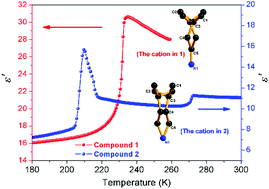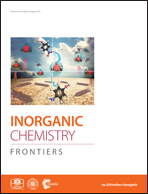Prominent dielectric transitions in layered organic–inorganic hybrids: (isoamyl-ammonium)2CdX4 (X = Cl and Br)†
Abstract
Layered organic–inorganic hybrids represent a class of technologically important materials due to their promising physical properties. In this report, two new layered organic–inorganic hybrid compounds (IAA)2CdX4 (IAA = isoamyl-ammonium cation, X = Cl, 1 and Br, 2) have been successfully synthesized and characterized. 1 undergoes a reversible solid-state phase transition at 230 K and 2 demonstrates three successive phase transitions and both of them exhibit prominent temperature-dependent dielectric behaviors. Detailed characterization was performed to investigate their phase transitions, including differential scanning calorimetry (DSC) measurements, variable-temperature structural analyses, variable-temperature powder X-ray diffraction (VT-PXRD) and dielectric measurements. The obvious difference in the phase transitions between 1 and 2 is originated from a bridged halogen effect, which makes different spaces between the inorganic framework layers where the organic IAA cation resides, resulting in different dynamic motions of the organic cations. These findings might be helpful to search for new dielectric materials based on layered organic–inorganic hybrid perovskites through exchange of the halogen atom.



 Please wait while we load your content...
Please wait while we load your content...